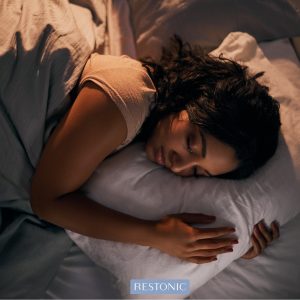Your go-to sleep position can tell you more about yourself than you think
Before drifting off to dreamland each night, there’s a good chance you slide into a familiar sleeping position. Maybe you roll over to your right side and pull your knees into your chest or perhaps you lie flat on your back, arms at your sides as if you’re in “corpse pose” at the end of a yoga class. While you may think this pre-sleep move is simply your way of getting comfy, it reveals a lot about your personality and your health.
What’s the best sleep position for better sleep AND better health?
 1. You sleep on your back. You’re more likely to be a Type A person. During the day, your confidence translates into a spine-straight position, which is also your way of discounting and overcoming anxiety. Being the ringleader and decision-maker of the family suits you well. What’s interesting, is that sleeping on your back is the most medically recommended position – but only 8% of us sleep this way. Your head, back, and spine maintain a neutral position with no extra pressure, which reduces aches come morning. Also, spending all night with your face out in the air, vs smooshed up against a pillow, may lead to fewer facial wrinkles.
1. You sleep on your back. You’re more likely to be a Type A person. During the day, your confidence translates into a spine-straight position, which is also your way of discounting and overcoming anxiety. Being the ringleader and decision-maker of the family suits you well. What’s interesting, is that sleeping on your back is the most medically recommended position – but only 8% of us sleep this way. Your head, back, and spine maintain a neutral position with no extra pressure, which reduces aches come morning. Also, spending all night with your face out in the air, vs smooshed up against a pillow, may lead to fewer facial wrinkles.
On the other hand, sleeping on your back is linked to sleep apnea, a serious medical condition. Gravity forces the base of the tongue to collapse into the airway, which obstructs breathing. If you suffer from sleep apnea, consider moving to your left side for a healthier (and quieter) night’s sleep.
 2. You sleep in a fetal position. You’re addicted to everything cozy and love cuddling. Spending Friday night in front of the fireplace while bingeing on Netflix sounds better than a night on the town. This is the most common sleeping position, so you’re in good company with the rest of the world. Own it, Baby.
2. You sleep in a fetal position. You’re addicted to everything cozy and love cuddling. Spending Friday night in front of the fireplace while bingeing on Netflix sounds better than a night on the town. This is the most common sleeping position, so you’re in good company with the rest of the world. Own it, Baby.
Sleeping in a fetal position is ideal for pregnant women but even if you’re not pregnant, you’re less likely to snore. While you’re the dream bedmate, this position can also be associated with arthritis and restricted breathing as you age. Curling up too tight can restrict blood flow and damage your spine (over time). Try adjusting slightly to lie more onto your back, which will improve circulation through the night.
 3. You sleep on your side. Even though you don’t love cuddling as much as the fetal sleepers, you’re still pretty darn sensitive – but a tough cookie during times of stress. You’re also accepting and open-minded to new situations. Snoozing with your arms stretched out at your sides is one of the most comfortable sleep positions. If you suffer from acid reflux and heartburn, switch to your left side for an easier time dozing off.
3. You sleep on your side. Even though you don’t love cuddling as much as the fetal sleepers, you’re still pretty darn sensitive – but a tough cookie during times of stress. You’re also accepting and open-minded to new situations. Snoozing with your arms stretched out at your sides is one of the most comfortable sleep positions. If you suffer from acid reflux and heartburn, switch to your left side for an easier time dozing off.
Side sleeping during pregnancy improves heart circulation and lowers lower backpressure. Even better, it works if you’re not expecting too. A word of caution – side-sleeping can cause nerve compression in the arms and legs, which can lead to chronic pain.
 4. You sleep on your stomach. You have decadent taste buds and love all things food, mainly because you digest what you’ve eaten so well from sleeping on your stomach. Other than digesting your food, stomach sleeping reduces snoring and can relieve some sleep apnea symptoms. But sleeping on your front is widely regarded as the worst sleeping position because it flattens the natural curve of your spine, which can lead to lower back pain. As well, sleeping all night with your head turned to one side also strains the neck. If this is your preferred position, try using pillows under one side of your belly to gradually train your body to sleep on one side.
4. You sleep on your stomach. You have decadent taste buds and love all things food, mainly because you digest what you’ve eaten so well from sleeping on your stomach. Other than digesting your food, stomach sleeping reduces snoring and can relieve some sleep apnea symptoms. But sleeping on your front is widely regarded as the worst sleeping position because it flattens the natural curve of your spine, which can lead to lower back pain. As well, sleeping all night with your head turned to one side also strains the neck. If this is your preferred position, try using pillows under one side of your belly to gradually train your body to sleep on one side.
 5. You sleep surrounded by your fur babies. At heart, you’re most likely the “parent” of your friend group and find it hard to say no to people. Putting yourself first has never been your strength but everyone loves you, especially your furry friends snuggling with you in bed.
5. You sleep surrounded by your fur babies. At heart, you’re most likely the “parent” of your friend group and find it hard to say no to people. Putting yourself first has never been your strength but everyone loves you, especially your furry friends snuggling with you in bed.
A 2014 sleep study found that people who slept with their pets took longer to fall asleep, were more likely to wake up tired and were more likely to be woken up by a dog barking or animal making noises. On average, people who share a bed with their pets, took 4 minutes longer to fall asleep than those who slept without pets. If you sleep with your pets, try a night or 2 without them and see how you feel in the morning.
Try the Goldilocks method for your next favorite sleep position
Regardless of health benefits, we sleep in the position our bodies find comfiest. But if you want to sleep better – and healthier – try the Goldilocks method for finding your next perfect sleep position. Experiment with different sleep positions until you find the one that’s just right for you. Whether it’s back, side, or stomach, you’ll likely wake up in the position that your body naturally moved to throughout the night. But if you keep trying every night when you go to bed, it is possible to change your sleeping position.
At the end of the day, unless a doctor specifically recommends switching, it’s probably best to keep doing what feels right.
Rest well & wake up ready to go!
Better sleep gives rise to better mornings, bringing your goals into focus and dreams within reach. Hungry for more sleep info? Dig into these posts:
- Will a sleep tracker help you sleep better?
- 5 ways to help you lose weight while you sleep
- Can melatonin help you get the good night’s sleep you’re craving?
Check out more about how your sleep position affects personality from our friends at Buzzfeed:
Eager for more sleep info you can really use?
Join our community
Facebook
and let's continue the conversation.
We'd love to hear what you have to say!
This blog does not provide medical advice. It is intended for general informational purposes only and does not address individual circumstances. It is not a substitute for professional medical advice, diagnosis or treatment and should not be relied on to make decisions about your health. Never ignore professional medical advice in seeking treatment because of something you have read on Restonic.com. If you think you may have a medical emergency, immediately call your doctor or dial 911.
